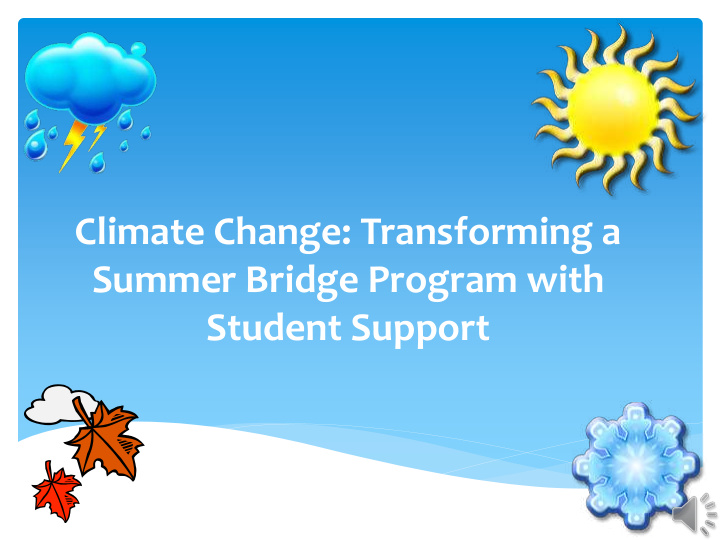



Climate Change: Transforming a Summer Bridge Program with Student Support
Program ogram Over erview view Session outcomes Climate change indicators in Higher Education Research indicators Institutional approaches to change Best practices approaches to change Forecast for the future
Presenter Introductions Ashley Langston Allison Bacigalupi Stacey Parker Director, Undergraduate Studies Advising Director, Center for Academic Academic Retention Coordinator Achievement Honors Program Center for Academic Achievement ACE Dual Enrollment Program Undergraduate Studies Undergraduate Studies Step Ahead Summer Bridge Florida Gulf Coast University Florida Gulf Coast University Undergraduate Studies Florida Gulf Coast University BS, Psychology B.A., Marketing & Management Methodist University BS, Economics – Rutgers University University of South Florida M.Ed. (CSA) – USF (2008) MBA – FGCU (2012) M.A., College Student Development M.Ed., College Student Affairs Appalachian State University (2005) University of South Florida (2011)
How many of you direct a summer program? How many of you advise students in a summer program? How many of you support a summer bridge program? How many of you went through a summer program as an undergraduate student? Is your summer program grant-funded? Is your summer program an institutional initiative?
Change Ahead Key Questions: How do we know Summ mmer er Brid idge e Progr ogram ams s work? k? How do we promo mote te college ege retention tion and comp mplet etion n rates? s? How do we assess ess readiness? diness? How w do you creat ate e campu pus buy- in? n? What t is needed ed to succeed ceed (acad ademi emica call lly y and soci cial ally) y)? How do we clearly rly meet objecti ctive ves? s?
Higher Education Influences/Changes Top op Ten en 1. Financial Aid Constraints 2. Increase in Minority FGIC Students 3. Student Profile (ACT/SAT, GPA) Demands vs. Reality 4. Serving Undocumented Students 5. Increases in the Gap – Students Falling Through to CC’s 6. The Expectation of a College Degree = More Students 7. Pressure for Time to Degree – Student Expectations 8. State/National Influences – Performance-Based Funding 9. State-Level Changes in Remediation Requirements 10. Generational Influences – in loco parentis
What the Research Says Retention of Under-Represented or At-Risk Students Noteworthy Structural Features of Summer Bridge Programs Strongly Recommended Components of Summer Bridge Programs Evaluation/Assessment of Summer Bridge Programs Model Programs
Institutional Background Florida Gulf Coast University Fort Myers, Florida a ka “Dunk City” Opened its doors in 1997 13,429 UG, 1018 GR, 226 NDS 77% of FTICs are full-time 46% from SWFL, 92% FL 7% Non-FL, 1.5% International Average ACT/SAT is 1570/23.1 Average FTIC HS GPA is 3.68 Service: >1.4 million hours Environment: 15-acre solar field, food forest, IDS 3920
Our Program FGCU Step Ahead Program 100 students/350 summer FTICs 25 = Writing (ENC 1130, 3 cr.) 75 = Math (MAT 1033, 3 cr.) 6-week Summer B Term (Mid June to Late July) Minimum Academic Profile: HS GPA > 3.00 Writing: 17, 420-430 OR Math: 17-18, 420-430 Required supplemental instruction or writing consultations, individualized academic coaching, student success workshops Option to take additional course to total six credits (Financial Aid)
Step Ahead Student Profile: Over the Years 2007 2008 2009 2010 2011 2012 2013 2014 2014 M M M M M M M M W Size 19 20 47 62 75 72 52 68 19 Diversity 63% 40% 34% 39% 50% 46% 52% 34% 32% HS GPA 3.09 3.12 3.33 3.24 3.22 3.28 3.29 3.53 3.58 ACT 16.9 16.9 17 16.96 16.95 17.19 17.12 17.30 16.14 SAT 410 392 404 406 410 408 402 416 402 Success 68.4% 75% 89.4% 87.1% 80% 84.7% 80.8% 95.6% 100% Cum GPA 3.12 3.05 3.12 3.08 2.82 2.96 2.84 2.58 2.52 Grad Rate 44.5% 53% 52.4% 32.14% 1.6% -- -- -- -- Persist 52.6% 58.8% 61.9% 67.3% 76.8% 60.7% 88.1% 82.4% 94.7%
Academic Support MAT 1033 – Intermediate Algebra ENC 1130 – Improving College Writing Complete Individual Academic Plan Complete Individual Academic Plan One Academic Coaching Appointment One Academic Coaching Appointment Motivation Workshop Motivation Workshop Three Student Success Workshops Three Student Success Workshops Six Supplemental Instruction Sessions Three Writing Consultations 96% of Step Ahead students met the minimum program requirements
Adapting to Change Creation of Step Ahead advisory committee (2009) Offered instructional support resources (2009) Began requiring instructional support, meetings, workshops (2009) Cohort students into courses through first year (2010) Added Motivation Workshop to summer requirements (2013) Provided academic support in first-year residence halls (South Village) (2013) Removal of conditional admission requirement to fully admit for fall (2014) Upgraded the courses taught (MA 101 MAT 1033) (2014) Addition of Writing cohort (aligned with QEP) (2014) Offered supplemental instruction for Step Ahead section of MAC 1105 College Algebra in the fall (2014)
The Future of Step Ahead 2015: Creating and requiring the Step Ahead Mentor Program (summer and fall) Requiring academic support in the fall semester Requiring academic advising sessions (summer and fall) Integrating points in the students’ grades for academic support requirements Beyond: Expanding to additional cohorts (more Writing, Reading, etc.) Increasing the academic profile of students admitted to the Program (just above remediation level) Expanding to other disciplines (i.e. Engineering, Biology, Health Professions, etc.) as gateways for their Programs
Adapting to Change How Do You Stay Afloat?
Best Practices Four Seasons of Success Spring: Pre-Program Summer: Program Winter: Assessment &Evaluation Fall: Post-Program
Program Wrap-Up Review of Program Goals Climate change indicators in Higher Education Research indicators Institutional approaches to change Best practices approaches to change Forecast for the future
Any Questions? Feel Free to Contact Us! Allison Bacigalupi Stacey Parker Ashley Langston abacigalupi@fgcu.edu sdparker@fgcu.edu alangston@fgcu.edu (239) 590-1096 (239) 590-7347 (239) 590-1868
Recommend
More recommend